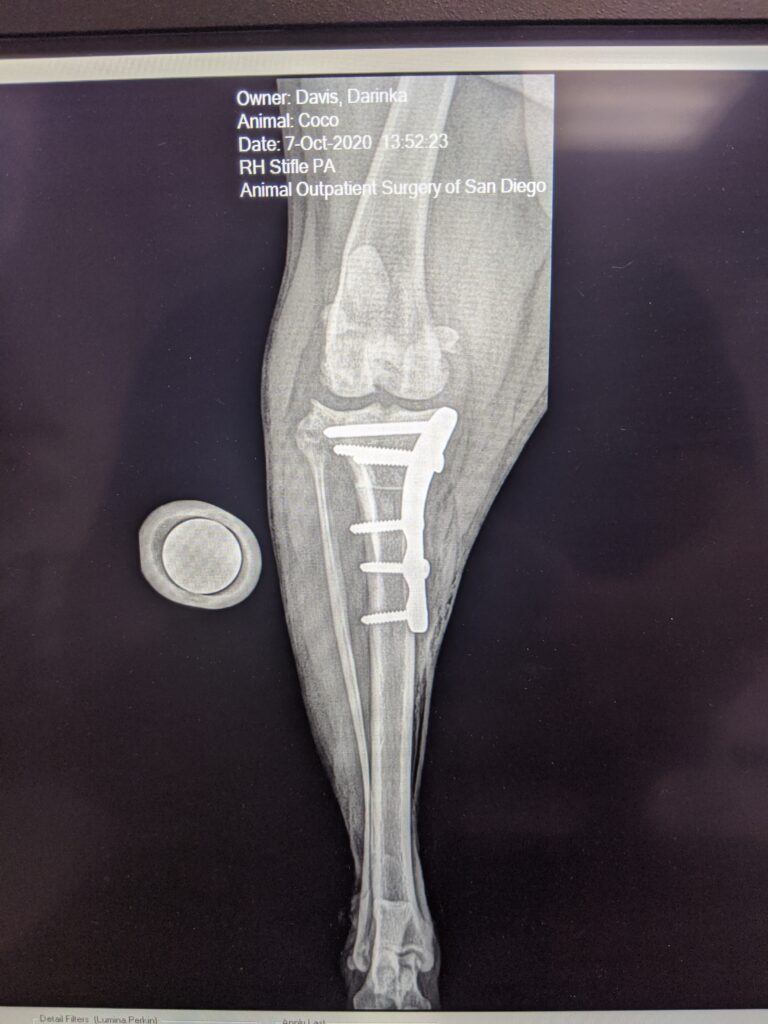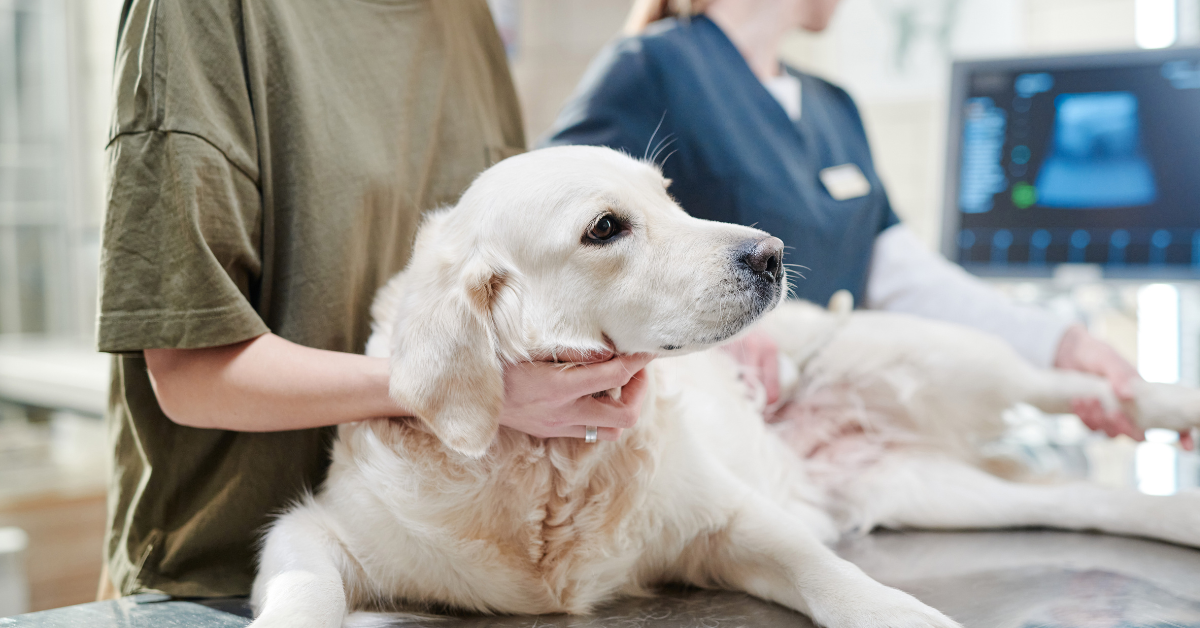You might be asking “What does TPLO surgery stand for?” TPLO stands for Tibial Plateau Leveling Osteotomy, and it’s a surgical procedure commonly performed in dogs to treat cranial cruciate ligament (CrCL) ruptures, which is equivalent to an anterior cruciate ligament (ACL) tear in humans. The cranial cruciate ligament is crucial for stabilizing the knee joint in dogs, and when it ruptures, it can lead to instability, pain, and arthritis in the affected joint.
TPLO surgery involves reshaping the tibial plateau, the top surface of the tibia bone, to change the mechanics of the knee joint and stabilize it without relying on the cranial cruciate ligament. This is achieved by cutting the bone, rotating it, and then stabilizing it with a metal plate and screws.
TPLO surgery is often preferred over other surgical techniques for CrCL rupture repair in dogs because it aims to provide more predictable and long-lasting results, allowing affected dogs to regain function and mobility in their affected limb more effectively. It’s considered a major orthopedic procedure and requires careful post-operative management and rehabilitation to optimize outcomes.
Why would my dog need a TPLO Surgery?
Your dog might need TPLO surgery if they are experiencing persistent lameness and instability in their stifle (knee) joint, which leads to pain and affects their quality of life. This instability and lameness are often caused by a rupture or partial tear of the cranial cruciate ligament (CrCL), which is crucial for stabilizing the knee joint in dogs. If left untreated, CrCL ruptures can lead to further joint damage, arthritis, and chronic pain.
A qualified veterinarian would recommend TPLO surgery after carefully evaluating your dog’s condition and considering various factors. This recommendation typically occurs when the benefits of surgery outweigh the risks, and when alternative methods of treatment, such as conservative management with medications, physical therapy, or less invasive surgical techniques, have not been successful in relieving your dog’s symptoms and restoring normal function to the affected limb.
TPLO surgery is particularly common in medium to giant dog breeds because they are more prone to CrCL ruptures due to their size and activity level. However, smaller breeds may also require TPLO surgery in certain cases, especially if they have a high degree of joint instability or if other treatment options have been ineffective.
Ultimately, the decision to proceed with TPLO surgery should be made in consultation with your veterinarian, who can provide personalized recommendations based on your dog’s specific condition, overall health, lifestyle, and treatment goals. They will also be able to discuss the potential risks and benefits of the surgery and answer any questions or concerns you may have.
How to identify my dog needs a TPLO Surgery
A torn or ruptured cranial cruciate ligament (CrCL) in dogs can manifest with several noticeable symptoms, including:
- Lameness: Dogs with a torn CrCL often exhibit lameness, which may vary in severity depending on the extent of the injury. The lameness may be sudden in onset or gradually worsen over time.
- Difficulty bearing weight: Affected dogs may have difficulty bearing weight on the affected limb, leading to limping or favoring of the uninjured limb.
- Swelling and joint effusion: The knee joint may appear swollen or have fluid accumulation (effusion) due to inflammation caused by the ligament injury.
- Pain: Dogs with a torn CrCL typically experience pain in the affected knee joint, which may be evident through vocalization, reluctance to move or be touched, or changes in behavior.
- Stiffness and reduced range of motion: The affected knee joint may become stiff, and the dog may exhibit a reduced range of motion due to pain and instability.
- Muscle atrophy: Chronic lameness and decreased use of the affected limb can lead to muscle atrophy (loss of muscle mass) in the thigh muscles of the affected limb.
- Difficulty rising or sitting: Dogs may have difficulty rising from a lying position or sitting down due to pain and instability in the knee joint.
- Clicking or popping sounds: In some cases, dogs with a torn CrCL may exhibit clicking or popping sounds when moving the affected joint, which can indicate joint instability or damage.
It’s important to note that the severity of symptoms can vary depending on factors such as the degree of ligament damage, the presence of concurrent joint pathology, the dog’s age, weight, and activity level, among others. Prompt veterinary evaluation and appropriate management, which may include surgery to stabilize the joint, can help alleviate pain, prevent further joint damage, and improve your dog’s quality of life.
Summary
In summary, to answer the question “What is TPLO?”, TPLO (Tibial Plateau Leveling Osteotomy) surgery is a veterinary procedure aimed at treating cranial cruciate ligament (CrCL) ruptures in dogs, which is equivalent to an ACL tear in humans. This surgical intervention involves reshaping the top surface of the tibia bone to stabilize the knee joint, thereby relieving pain, preventing irreversible joint damage, and promoting a return to normal, active, and pain-free function for the dog.
Qualified and experienced veterinarians typically recommend TPLO surgery after careful evaluation of the dog’s condition, considering factors such as the severity of symptoms, the extent of ligament damage, the dog’s size, breed, age, and activity level.
Symptoms indicating the need for TPLO surgery include persistent lameness, difficulty bearing weight on the affected limb, swelling and joint effusion, pain, stiffness, reduced range of motion, muscle atrophy, and difficulty rising or sitting. These symptoms may develop gradually over time due to the slow degeneration of the cranial cruciate ligament, or they may result from acute trauma to the knee joint.
Early detection and intervention are crucial for managing CrCL disease in order to prevent further damage to structures in the knee. Therefore, dog owners should seek prompt veterinary evaluation if their dog exhibits any of the aforementioned symptoms, as timely diagnosis and appropriate treatment, including TPLO surgery when indicated, can significantly improve the dog’s quality of life and long-term joint health.
Schedule a consultation with the Animal Outpatient Surgery of San Diego today for assurance and guidance.
Works Cited
Giansetto, T., Picavet, P.P., Lefebvre, M. & Balligand, M. 2022a. Determination of the Stifle Angle at Standing Position in Dogs. Veterinary Sciences. 9(11):644. DOI: 10.3390/vetsci9110644.
Nanda, A. & Hans, E.C. 2019. Tibial Plateau Leveling Osteotomy for Cranial Cruciate Ligament Rupture in Canines: Patient Selection and Reported Outcomes. Veterinary Medicine: Research and Reports. 10:249–255. DOI: 10.2147/VMRR.S204321.



